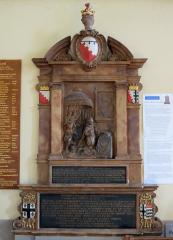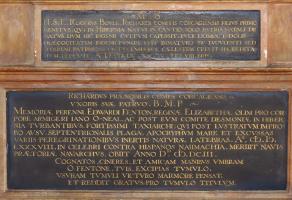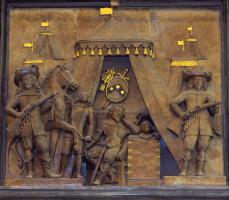 Roger Boyle and Capt. Edward Fenton monument.
Roger Boyle and Capt. Edward Fenton monument.
 Roger Boyle and Capt. Edward Fenton monument.
Roger Boyle and Capt. Edward Fenton monument.
In the Church of St Nicholas, Deptford, in South London, is the grand Elizabethan monument to the Hon. Roger Boyle, d.1615, first son of Richard Boyle, Earl of Cork in Ireland, and Captain Edward Fenton, d.1605, who captained the Admiral’s ship at the battle with the Spanish Armada, and had other naval victories over the Spanish, and commanded an unsuccessful attempt at discovering the North West Passage. Fenton was the uncle of Richard Boyle. It consists of a large alabaster monument with an alto relievo scene with figure sculpture. The main figure, who presumably is Fenton, is shown as a young man with tunic, pantaloons, high boots and a ruff, kneeling on a tasselled cushion, with his prayer desk in front of him. This is the usual depiction of a Tudor or Elizabethan monument, but here, the figure has one hand on his open bible, the other praying, and has his body turned so as to look outward towards the viewer, which is a much more naturalistic treatment than the usual stiff, praying figure. Behind him, a cherub desports himself, one harm raised to push up the hanging drape of a canopy of a tent-like structure above; within this, is a covered desk with a skull upon it, probably the mark of a philosopher rather than being a memento mori. The little lion underfoot suggests some hearkening to St Jerome. On the rear wall, a painting hangs, with the scene indicated in low relief, showing a coastline with a couple of houses clustered in front of a church, and a choppy sea with ships and then a further coastline; perhaps indicating the defeat of the Armada.
The rest of the monument quite nicely illustrates the parts of a Classical Baroque mural monument. Thus we have pilasters (flat pillars) to the sides, their capitals being of the Ionic order, and outside of these, set-back or receded pilasters, rather simply formed, and each bearing a painted shield of arms. Above is a blank frieze or entablature, and on top is the pediment, which in this case is curved, and broken, with in front of it a large painted cartouche of arms, with a knight’s helm on top. The inscriptions are on the sideboard like base, and to the outer sides are further arms and minor scrolling. A good example of an Elizabethan mural monument in the grand manner, and known to be by a significant early English sculptor, Epiphanius Evesham and completed by James White. Epiphanius Evesham is an interesting figure, though too early for this website, the fourteenth child of William Evesham of Wellington, who moved to London with his family as a young man or youth, going to Paris by 1600, and staying in France at least until 1615 before returning to London. A handful of monuments are signed by him, mostly in Kent – and Deptford was in Kent too until the growth of London in the 20th Century led to its absorption into the London borough of Greenwich. A large number of other works have been ascribed to him, particularly by Mrs Esdaile, the pioneering monumental historian in England, but many of her attributions were based on style rather than documentary evidence, and rejected by later writers. Annoyingly, none of the later works proposed as being by Evesham has been proven, so it may be that his career was not so long and ended during the 1620s, rather than the decade or so later often cited. An example of such an attribution, alabaster with low relief carving, is the monument to Jacob Wheeler, d.1627, in All Saints Church, High Wycombe. James White is a less notable figure, chiefly known for his monument to the father of the Earl of Corke, also called Roger Boyle, and his wife, in the Church of Preston, Faversham, Kent.
Inscriptions (click to enlarge).
There is of course a whole genre of kneeler monuments, dating from the mid-16th Century through to the 1640s. While at their grandest they include life-sized free-standing statues, there are plenty of examples of the carved figures being attached to the base or in high relief, as here in Deptford. Below is an example of such a work, of similar date and with somewhat a similar type of surround, being the monument to Katharine Hart, d.1605, in All Saints Church, Fulham. The stiffness of the figures is much more typical of the type than the Deptford example. But the piece that immediately came into my mind when I saw the Fenton monument was the panel to Martin Bond in St Helen Bishopsgate. It is a generation later, as he died in 1643, but again we have a tent, with the principle figure here seated inside it. Lots more on kneeler monuments on this page.
 Martin Bond panel, St Helen's Bishopsgate.
Martin Bond panel, St Helen's Bishopsgate.
With many thanks to the Revd. Louise Codrington-Marshall for permission to show pictures of the monument in St Nicholas, Deptford.
This page was originally part of a 'sculpture of the month' series, for November 2015. Although the older pages in that series have been absorbed within the site, if you would wish to follow the original monthly series, then jump to the next month (Dec. 2015) or the previous month (Oct 2015). To continue, go to the bottom of each page where a paragraph like this one allows you to continue to follow the monthly links.
St Nicholas Deptford // St Paul Deptford // Deptford Town Hall // Monuments in some London Churches // Introduction to church monuments
Angel statues // Cherub sculpture
Visits to this page from 1 November 2015: 4,819